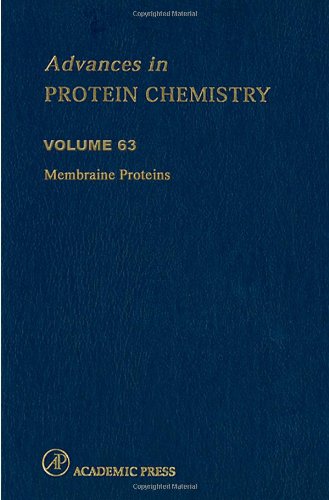

Most ebook files are in PDF format, so you can easily read them using various software such as Foxit Reader or directly on the Google Chrome browser.
Some ebook files are released by publishers in other formats such as .awz, .mobi, .epub, .fb2, etc. You may need to install specific software to read these formats on mobile/PC, such as Calibre.
Please read the tutorial at this link. https://ebooknice.com/page/post?id=faq
We offer FREE conversion to the popular formats you request; however, this may take some time. Therefore, right after payment, please email us, and we will try to provide the service as quickly as possible.
For some exceptional file formats or broken links (if any), please refrain from opening any disputes. Instead, email us first, and we will try to assist within a maximum of 6 hours.
EbookNice Team

Status:
Available0.0
0 reviews(Ebook) Membrane Proteins 1st Edition by Douglas C Rees - Ebook PDF Instant Download/Delivery: 9780120342631 ,0120342634
Full download (Ebook) Membrane Proteins 1st Edition after payment

Product details:
ISBN 10: 0120342634
ISBN 13: 9780120342631
Author: Douglas C Rees
This volume covers 2 major topics: Foundations and Membrane Protein Structures.
Key Features
* Foundations
* Bioenergetic Processes
* Channels and Receptors
(Ebook) Membrane Proteins 1st Edition Table of contents:
Chapter 1. Membrane Protein Assembly in Vivo
I. Introduction
II. Overview of Membrane Protein Assembly Pathways in Prokaryotic and Eukaryotic Cells
III. Membrane Protein Assembly in the ER
IV. Membrane Protein Assembly in Escherichia coli
V. Membrane Protein Assembly in Mitochondria
VI. Membrane Protein Assembly in Chloroplasts
VII. Membrane Protein Assembly in Peroxisomes
VIII. Conclusions
References
Chapter 2. Construction of Helix-Bundle Membrane Proteins
I. Introduction
II. Transmembrane Helix Structure
III. Thermodynamic Studies
IV. The Contribution of Loops versus Transmembrane Helices
V. Forces That Stabilize Transmembrane Helix Interactions
VI. Conclusions
References
Chapter 3. Transmembrane β-Barrel Proteins
I. Introduction
II. Structures
III. Construction Principles
IV. Functions
V. Folding and Stability
VI. Channel Engineering
VII. Conclusions
References
Chapter 4. Length, Time, and Energy Scales of Photosystems
I. Introduction
II. Overview of Length Scales in Bioenergetic Membranes
III. Managing Lengths in Natural Redox Protein Design
IV. Managing Length and Size in Natural Light-Harvesting Design
V. Managing Distance in Electron Transfer
VI. Managing Proton Reactions in Photosynthesis
VII. Managing Diffusion in Photosynthesis
VIII. Summary
References
Chapter 5. Structural Clues to the Mechanism of Ion Pumping in Bacteriorhodopsin
I. Introduction
II. The Ground, or Resting, State
III. Early Photocycle Intermediates (K and L)
IV. M Intermediates
V. Large-Scale Conformational Changes in the M, N, and O Intermediates
VI. Protonation Pathways in the M to N and the N to O Reactions
References
Chapter 6. The Structure of Wolinella succinogenes Quinol: Fumarate Reductase and Its Relevance to
I. Introduction
II. Overall Description of the Structure
III. The Hydrophilic Subunits
IV. Subunit C, the Integral Membrane Diheme Cytochrome b
V. General Comparison of Membrane-Integral Diheme Cytochrome b Proteins
VI. Relative Orientation of Soluble and Membrane-Embedded QFR Subunits
VII. The Site of Menaquinol Oxidation/Menaquinone Reduction
VIII. Electron and Proton Transfer and the Wolinella succinogenes Paradox
IX. The E-Pathway HypothesisŽ of Coupled Transmembrane Electron and Proton Transfer
X. Concluding Remarks
References
Chapter 7. Structure and Function of Quinone Binding Membrane Proteins
I. Introduction
II. Structure of Cytochrome bc1 Complex from Bovine Heart Mitochondria
III. The Structure of Cytochrome bo3 Ubiquinol Oxidase from Escherichia coli
IV. Conclusion
References
Chapter 8. Prokaryotic Mechanosensitive Channels
I. Introduction
II. MscL: Structure and Mechanism
III. MscS and Other Prokaryotic Mechanosensitive Channels
IV. What Makes a Mechanosensitive Channel Mechanosensitive?
V. Concluding Remarks
References
Chapter 9. The Voltage Sensor and the Gate in Ion Channels
I. Introduction
II. The Voltage Sensor
III. The Channel Gate
References
Chapter 10. Rhodopsin Structure, Dynamics, and Activation: A Perspective from Crystallography, Site-
I. Introduction to Rhodopsin and Visual Signal Transduction
II. The Rhodopsin Crystal Structure: The Inactive State
III. Structure and Dynamics of Rhodopsin in Solutions of Dodecyl Maltoside: The Cytoplasmic Surface
IV. Location of the Membrane–Aqueous Interface and the Structure of the Disk Membrane
V. Photoactivated Conformational Changes: The Rhodopsin Activation Switch
VI. Summary: The Mechanism of Rhodopsin Activation and Future Directions
References
Chapter 11. The Glycerol Facilitator GlpF, Its Aquaporin Family of Channels, and Their Selectivity
I. An Ancient and Long Recognized Channel
II. Three-Dimensional Structure of GlpF with Glycerol in Transit
III. The Basis for Selectivity through the Channel
IV. Roles of Conserved Residues: Functional and Structural
V. Stereoselective Preferences of GlpF among Linear Alditols
VI. Simulations and Rates of Glycerol Passing through the Channel
VII. Simulation and Rates of Water Passage through the GlpF (an AQP) Channel
VIII. Insulation against Proton Conduction in AQPs
IX. Quaternary Structure of GlpF (and AQPs)
X. The Ion Channel in AQP6; a Possible Pore on the Fourfold Axis of AQPs?
XI. GlpF Channel Selectivity for Antimonite
XII. Selectivity against Passing Ions or an Electrochemical Gradient
XIII. The Various Contributions to Rejection of Proton Conductance
XIV. Selectivity for Glycerol versus Water
XV. Regulated Ion Channels Formed by Members of the AQP Family
People also search for (Ebook) Membrane Proteins 1st Edition:
cell membrane proteins
plasma membrane proteins
label the types of plasma membrane proteins
integral membrane proteins function
rbc membrane proteins
Tags: Douglas C Rees, Membrane Proteins